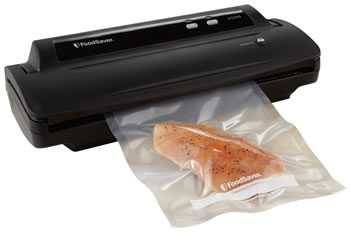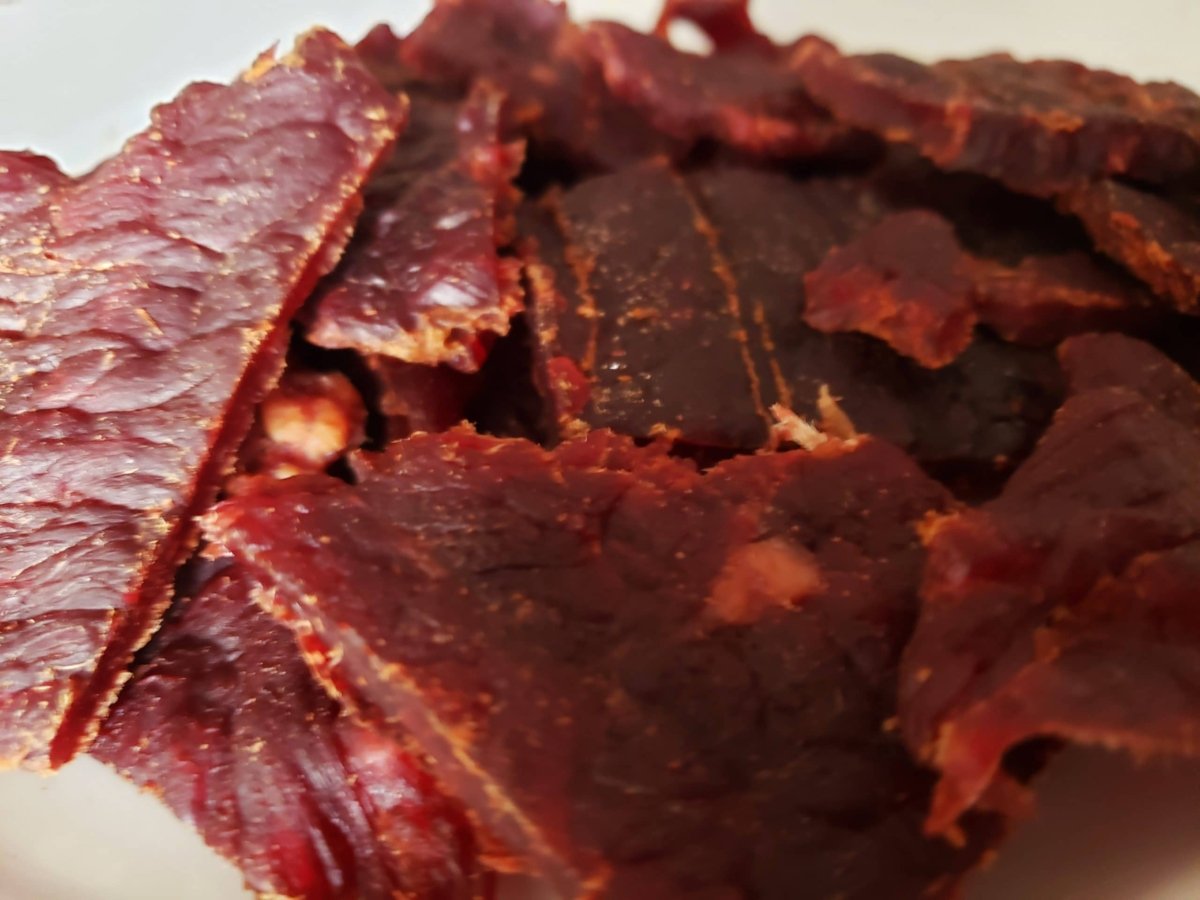The quality of store-bought jerky can be hit or miss so why roll the dice when you can make it better at home?
Jerky is a fun snack, but it is far more versatile than you might imagine. Like BLT sandwiches? Bench the bacon and play the jerky. Like bacon in your salad? Jerk it and replace it. Many of the things bacon can do, jerky can do too, often better!
For the uninitiated, jerky is dried meat that retains much of the nutritional value of fresh meat but weighs less than half and takes up a lot less space. And it is a lot healthier than you think. Start by looking at the ingredient list of a bag of jerky in the store. Now look at the ingredient list in the recipe below. USDA calls it “nutrient dense.” We eat it as a treat nowadays, but in the days before refrigeration, it was once an important source of protein.
Jerky has probably been around since soon after man started eating meat since it is kept for days or weeks without refrigeration. It became famous in the US as cowboy food for long cattle drives. Cowboys could pack it in saddle bags and snack on it while mounted. It was lunch. According to historians jerky has been around since since ancient Egypt. Early hunter-gatherers and nomadic tribes made jerky from animals that were too big to eat all at once. It was probably just thin strips of sun-dried meat. Soaking in salt water before drying was probably an early innovation since salt helped fight off bacteria and helped it keep longer. It probably didn’t take long to discover that smoking it made it taste better and the properties of the smoke helped it keep longer still.
The concept has many forms. Biltong is dried meat popular in many African countries. Amerindians ground dried meat and dried fruit to make pemmican. The word “jerky” is believed to have come from the Spanish word charque which means roughly “dried meat.”
Over the years the process has been reinvented to improve safety, shelf life, and flavor. Most store-bought jerky is dry and leathery because it is salt-cured, chemically preserved, smoked or treated with liquid smoke, and processed to meet USDA standards for storage at room temp. Homemade jerky, properly made, can be better tasting, and probably better for you. Let’s look at the different methods of making jerky.
Dry cured. This is the true, classic, traditional cowboy jerky, and jerky elitists and survivalists will tolerate no other approach. When done properly, it is tasty and salty, has a shelf life of a year or more at room temp in the bomb shelter, and is home on the range or in backpacks. This method is best reserved for commercial producers because the meat is not cooked and can harbor pathogens if not handled properly. Here’s a rough overview of the process, although there are many variations: Thin slices of meat are packed on all sides with a mix of salt, sugar, and spices. The meat is refrigerated for at least two days, and then it is cold smoked and dehydrated at low temps for days. Many folks consider this method risky, and they use a commercial product called Morton’s Tender Quick as a preservative. It contains salt, sugar, sodium nitrate, and sodium nitrite as curing agents, and propylene glycol to keep the mixture uniform.
Wet cured. Considered a shortcut by some elitists, the meat is sliced and soaked in a concentrated salty brine that has been flavored with spices and a sweetener like sugar, molasses, or honey. Liquid smoke is a common addition. The meat is then removed and dried in a cold smoker, dehydrator, or oven. Tender Quick can also be used. This is the method preferred by commercial producers.
Marinated. My favorite method is easy, safe, and more flavorful. It is a lot like wet cured, only the salt concentration is lower, the flavorings are more intense, and there are no preservatives. Although these jerkies must be refrigerated for long-term storage they can be taken out long enough to accompany you to a game, concert, or camping trip. The recipe below has a lot of flexibility, but I recommend you stick close to my plan the first time out. Then riff away.
Other uses for jerky
Sometimes I will not smoke and dry all the meat. Sometimes I will set some aside and just grill it over high heat and then:
1) Throw it on a sammie with lettuce and tomato.
2) Throw it on a bed of rice like Korean Kalbi with thinly sliced green onions, toasted sesame seeds, and some orange zest.
3) Serve it in a wrap of lettuce leaves or a wrap of tortilla.
4) Use it in tomato sauce.
Tell me how you use your jerky below in our comments section.
Makes:
Takes:
Ingredients
- 2 pounds eye of round beef
- 1 cup soy sauce
- 1/2 cup molasses, honey, or sorghum
- 1/4 cup Bourbon, Scotch, dark rum, brandy, or other dark whiskey
- 1 knob of fresh ginger
- 3 tablespoons Kansas City style barbecue sauce
- 3 tablespoons Meathead’s Memphis Dust
- 2 teaspoons Morton Coarse Kosher Salt
- 1 tablespoon hot sauce
These recipes were created in US Customary measurements and the conversion to metric is being done by calculations. They should be accurate, but it is possible there could be an error. If you find one, please let us know in the comments at the bottom of the page
Method
- Prep. Peel and grate enough ginger to create 5 tablespoons.
- To slice the beef, begin by putting the meat in the freezer for an hour or two to stiffen it and make it easier to cut. Cut the meat in disks about 1/8 to 1/4" (3.2 to 6.4 mm) thick. Strive to make them uniform in thickness. You don't want them paper thin because they will shrink in half, but you don't want it too thick or it will take forever to dry. I like to cut across the grain to make it less chewy. Some folks cut with the grain to give their mandibles more of a workout. They won't be long strips like bacon. Odd shapes are good. They tell people that it is home made. Put the meat a 1 gallon (3.8 L) zipper bag.
- Marinate. Mix the marinade by whisking all the ingredients together. Pour it into the zipper bag. Put the bag in a bowl or pan in the refrigerator to catch any leaks. Let the marinade make love to the meat all night long at least. Occasionally pick up the bag and roll it around massaging it for several minutes to make sure the liquid is contacting all the meat surfaces. This is important. It can stay in the marinade for up to 2 days if you wish. When you are ready to cook, drain the meat in a colander and discard the marinade. Do not save it for another day.
- Fire up. After the meat is done marinating, set up your grill for 2-zone indirect cooking shooting for about 200°F (93.3°C) in the indirect zone. Get that wood right on the heat source to make sure it smokes. On a gas grill you will want to put it in an aluminum foil packet and poke holes in it. If you wish, you can prop open the lid of your cooker to let heat escape in order to keep the cooking temp down. This will also increase air flow. If you normally use a water pan, skip it today. The goal is dehydration not moisturizing.
- Cook. Spread the meat on a grill grate or a grill topper. I am a big fan of the non-stick narrow mesh Frogmats do the job, especially since they can be cleaned in the dishwasher. Make sure the meat is not folded over on itself or overlapping. You can use both lower and upper grates if your setup allows. Smoke for about 15 to 60 minutes. That'll kill the bugs and add smoke flavor. If you are using a grill and the heat is on one side, then you may need to rotate the meat so the stuff on the cooler side goes to the hot side after about 30 minutes. This will get the center of the meat up past the kill zone and start the dehydration. Keep an eye on it during the cooking process so it doesn't get too dry.Jerky elitists don't like the idea of cooking the meat, but it is absolutely necessary to make the meat safe if you are not using a preservative and even then, cold smoking is risky and I cannot recommend it for home cooks. Smoke is not necessary, but it adds a pleasing BBQ flavor and improves shelf life in the fridge. A good digital oven thermometer is important for this phase unless you've been hankering to get up close and personal with Salmonella, E. coli O157:H7, and Listeria monocytogenes. You cannot trust your grill's bi-metal dial thermometer. It can be off by as much as 50°F (10°C). Click here for the USDA guidelines for commercial jerky production.
- Dehydrate. The final step is dehydration. You can stop smoking and cooking and dry the meat to jerky consistency. That means dark, almost black, but not carbonized, pliable but breakable, but not so brittle that it shatters. Drop the cooker's air temp to no lower than 140°F (60°C) and hold it there. If you have an indoor kitchen dehydrator, you can move the meat there at this stage. They are great because they have a fan and that can reduce drying time to less than 6 hours. I have an article about electric dehydrators here. Or you can put it in your oven, just leave the door cracked open a bit. Drying on a grill or in the oven can take as long as 12 to 18 hours depending on the temp and how thick the meat is. It is hard to get a grill or smoker or even indoor oven down to 140°F (60°C), so just get as low as you can. If you need to, you can leave the lid or door partially open to dissipate the heat. The hotter it is the crunchier the meat will get, but you want a balance between crunchy and chewy. You want jerky, not hard candy.

- During the process, the meat will start out tan in color, progress through rosy, and eventually blacken. But it is not really black. It is just really really dark. You want to remove it right after the last bit of rose color disappears. But that's my preference. It will also lose about half it's weight. As it starts to go, start tasting. Learn what texture you like best. This might require a lot of tasting. And beer. And friends to offer their opinions.
- Serve. Enjoy immediately or store for later. The drier it gets, the longer it keeps. How long? If you have been careful about cleanliness and hit the temperature guidelines above (this is especially important for game), USDA says it can be stored safely a month or two at room temperature. I use a vacuum sealer and keep mine in the fridge just to be sure. And yes, it can be frozen.





High quality websites are expensive to run. If you help us, we’ll pay you back bigtime with an ad-free experience and a lot of freebies!
Millions come to AmazingRibs.com every month for high quality tested recipes, tips on technique, science, mythbusting, product reviews, and inspiration. But it is expensive to run a website with more than 2,000 pages and we don’t have a big corporate partner to subsidize us.
Our most important source of sustenance is people who join our Pitmaster Club. But please don’t think of it as a donation. Members get MANY great benefits. We block all third-party ads, we give members free ebooks, magazines, interviews, webinars, more recipes, a monthly sweepstakes with prizes worth up to $2,000, discounts on products, and best of all a community of like-minded cooks free of flame wars. Click below to see all the benefits, take a free 30 day trial, and help keep this site alive.
Post comments and questions below
1) Please try the search box at the top of every page before you ask for help.
2) Try to post your question to the appropriate page.
3) Tell us everything we need to know to help such as the type of cooker and thermometer. Dial thermometers are often off by as much as 50°F so if you are not using a good digital thermometer we probably can’t help you with time and temp questions. Please read this article about thermometers.
4) If you are a member of the Pitmaster Club, your comments login is probably different.
5) Posts with links in them may not appear immediately.
Moderators